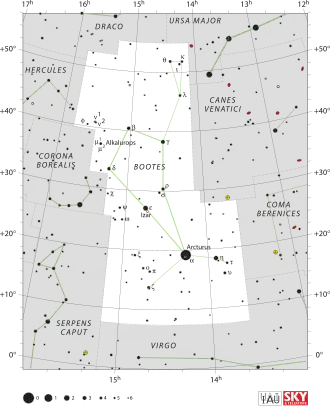Mu2 Boötis
 Location of μ2 Boötis (circled) | |
| Observation data Epoch J2000 Equinox J2000 | |
|---|---|
| Constellation | Boötes |
| A | |
| Right ascension | 15h 24m 30.86726s[1] |
| Declination | +37° 20′ 50.2761″[1] |
| Apparent magnitude (V) | 6.98[2] |
| B | |
| Right ascension | 15h 24m 30.89704s[3] |
| Declination | +37° 20′ 52.5550″[3] |
| Apparent magnitude (V) | 7.63[2] |
| Characteristics | |
| Spectral type | F9V + G0V[4] |
| U−B color index | +0.13[5] |
| B−V color index | +0.59[5] |
| Astrometry | |
| A | |
| Proper motion (μ) | RA: −139.142[1] mas/yr Dec.: +90.281[1] mas/yr |
| Parallax (π) | 27.2223±0.0168 mas[1] |
| Distance | 119.81 ± 0.07 ly (36.73 ± 0.02 pc) |
| B | |
| Proper motion (μ) | RA: −152.149[3] mas/yr Dec.: +89.593[3] mas/yr |
| Parallax (π) | 27.2126±0.0181 mas[3] |
| Distance | 119.85 ± 0.08 ly (36.75 ± 0.02 pc) |
| Orbit[4] | |
| Primary | A |
| Companion | B |
| Period (P) | 265 yr |
| Semi-major axis (a) | 1.46″ |
| Eccentricity (e) | 0.585 |
| Inclination (i) | 135.5° |
| Longitude of the node (Ω) | 174° |
| Periastron epoch (T) | 1864.9 |
| Argument of periastron (ω) (secondary) | 338° |
| Details | |
| A | |
| Mass | 1.24[4] M☉ |
| Radius | 1.23[1] R☉ |
| Luminosity | 1.75[1] L☉ |
| Surface gravity (log g) | 4.3[4] cgs |
| Temperature | 6,000[4] K |
| Rotational velocity (v sin i) | 5[4] km/s |
| Age | 5.6[1] Gyr |
| B | |
| Mass | 1.05[4] M☉ |
| Radius | 1.09[3] R☉ |
| Luminosity | 1.06[3] L☉ |
| Surface gravity (log g) | 4.4[4] cgs |
| Temperature | 5,900[4] K |
| Rotational velocity (v sin i) | 9[4] km/s |
| Age | 11.3[3] Gyr |
| Other designations | |
| 51 Boo B, BD+37°2637, GC 20725, GJ 3904, HD 137392, HIP 75415, HR 5734, SAO 64687 | |
| Database references | |
| SIMBAD | data |
Mu2 Boötis is a binary star in the northern constellation of Boötes. Its name is a Bayer designation that is Latinized from μ2 Boötis, and abbreviated Mu2 Boo or μ2 Boo. Based on parallax measurements, these stars are located at a distance of approximately 120 light-years from the Sun.
The components of μ2 Boötis have apparent magnitudes of +7.0 and +7.6.[2] They have similar spectral types, F9V and G0V respectively, and complete one orbit about their common centre of mass every 260 years.[4]
The system μ1 Boötis is at a similar distance and share similar proper motions with μ2, but has a significantly different chemical composition, so they are not gravitationally bound.[4]
References
- ^ a b c d e f g h Vallenari, A.; et al. (Gaia collaboration) (2023). "Gaia Data Release 3. Summary of the content and survey properties". Astronomy and Astrophysics. 674: A1. arXiv:2208.00211. Bibcode:2023A&A...674A...1G. doi:10.1051/0004-6361/202243940. S2CID 244398875. Gaia DR3 record for this source at VizieR.
- ^ a b c Tokovinin, Andrei (2018-03-01). "The Updated Multiple Star Catalog". The Astrophysical Journal Supplement Series. 235 (1): 6. arXiv:1712.04750. Bibcode:2018ApJS..235....6T. doi:10.3847/1538-4365/aaa1a5. ISSN 0067-0049.
- ^ a b c d e f g h Vallenari, A.; et al. (Gaia collaboration) (2023). "Gaia Data Release 3. Summary of the content and survey properties". Astronomy and Astrophysics. 674: A1. arXiv:2208.00211. Bibcode:2023A&A...674A...1G. doi:10.1051/0004-6361/202243940. S2CID 244398875. Gaia DR3 record for this source at VizieR.
- ^ a b c d e f g h i j k l Kiyaeva, O. V.; et al. (November 2014). "The multiple system ADS 9626: A quadruple star or an encounter of two binaries?". Astronomy Reports. 58 (11): 835–848. Bibcode:2014ARep...58..835K. doi:10.1134/S106377291411002X. S2CID 122667185.
- ^ a b Johnson, H. L.; et al. (1966). "UBVRIJKL photometry of the bright stars". Communications of the Lunar and Planetary Laboratory. 4 (99): 99. Bibcode:1966CoLPL...4...99J.